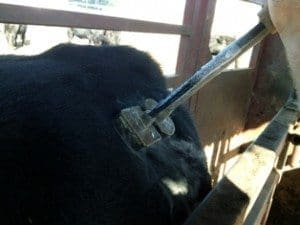Freeze branding is considered to cause less pain to animals than hot iron branding, and, when cattle must be branded for legal or practical reasons (see list of legal requirements for each state regarding branding in this article), it is the method of branding preferred by the Australian Veterinary Association and the RSPCA.
How practical is freeze branding for large commercial beef cattle herds?
Glen Fraser, based in Colac, Victoria, is an AI and freeze branding technician with the HICO herd improvement cooperative.
He applies freeze brands to around 15,000-18,000 cattle a year, mainly dairy cattle and some stud beef cattle.
Freeze branding has the effect of turning the pigmentation of dark skin and hair cells white and is obviously most effective for darker breeds such as Angus, Wagyu and red coated cattle, and less effective for lighter coated breeds.
The procedure typically involves running cattle into a race, clipping the area to be branded, applying antiseptic and then branding with an alloy freeze brand cooled with either liquid nitrogen or dry ice.
Mr Fraser said freeze branding with liquid nitrogen typically requires the brand to be held in place for around 15-20 seconds, while dry ice, which he said produces a whiter, ‘more crisp’ brand, can take up to 40 seconds.
Animals must also be standing still while the brand is applied, he said, to ensure brands are applied effectively. Most of the cattle he brands are around 14 months old because at that age they fit more tightly in a crush.
Producers in Victoria are currently paying around $4.50/animal to have liquid nitrogen brands applied, and $6.50-$7 for dry ice.
By contrast hot iron branding takes a few seconds to apply and its cost per head is negligible.
Mr Fraser said most beef operations he was aware of that currently use freeze branding are studs and smaller hobby operations. The process would be time-consuming for operations that were branding more than 100 calves a day, he said.
Mr Fraser also provides a dehorning service and said there was increasing pressure being applied from large dairy companies such as Saputo for producers to use pain relief for that procedure.
He is licensed by a veterinarian to provide lignocaine injections to dairy calves prior to dehorning and said demand for the pain relief procedure is increasing.
Australian Animal Welfare Standards and Guidelines for Cattle:
The writing group which drafted Australian Animal Welfare Standards and Guidelines for Cattle, released in released in May last year, noted that hot iron (fire) branding remained an important method of visual identification for much of the Australian cattle herd.
It said branding was important practice especially for extensively managed herds, where there is no alternative of simple and permanent identification that is 100pc reliable.
The group also noted that freeze branding has limited applications because:
- High level of preparation required including clipping and swabbing
- Requirement for liquid nitrogen, dry ice and alcohol procurement and storage
- Long contact time necessitating longer restraint time
- The brand is not visible on white or grey cattle.
The group said circumstances would dictate the method used, with no one method being ideal in all circumstances.
“The most widely used methods are associated with some degree of pain but the writing group did not consider it necessary to mandate a requirement for pain relief,” the group wrote in its discussion paper released February 2013.
Topper Leather based in Sydney buys salted and green hides from many Australian beef processors. Principal Brian Topper told Beef Central that a typical hide fire-branded on the rump (a ‘southern’ hide, with no tick damage) could be reduced in value by $5-$8 compared with the same hide, brand-free.
See this morning’s related articles:
Pain relief: What options are currently available?
Legal requirements for cattle branding in each State and Territory

